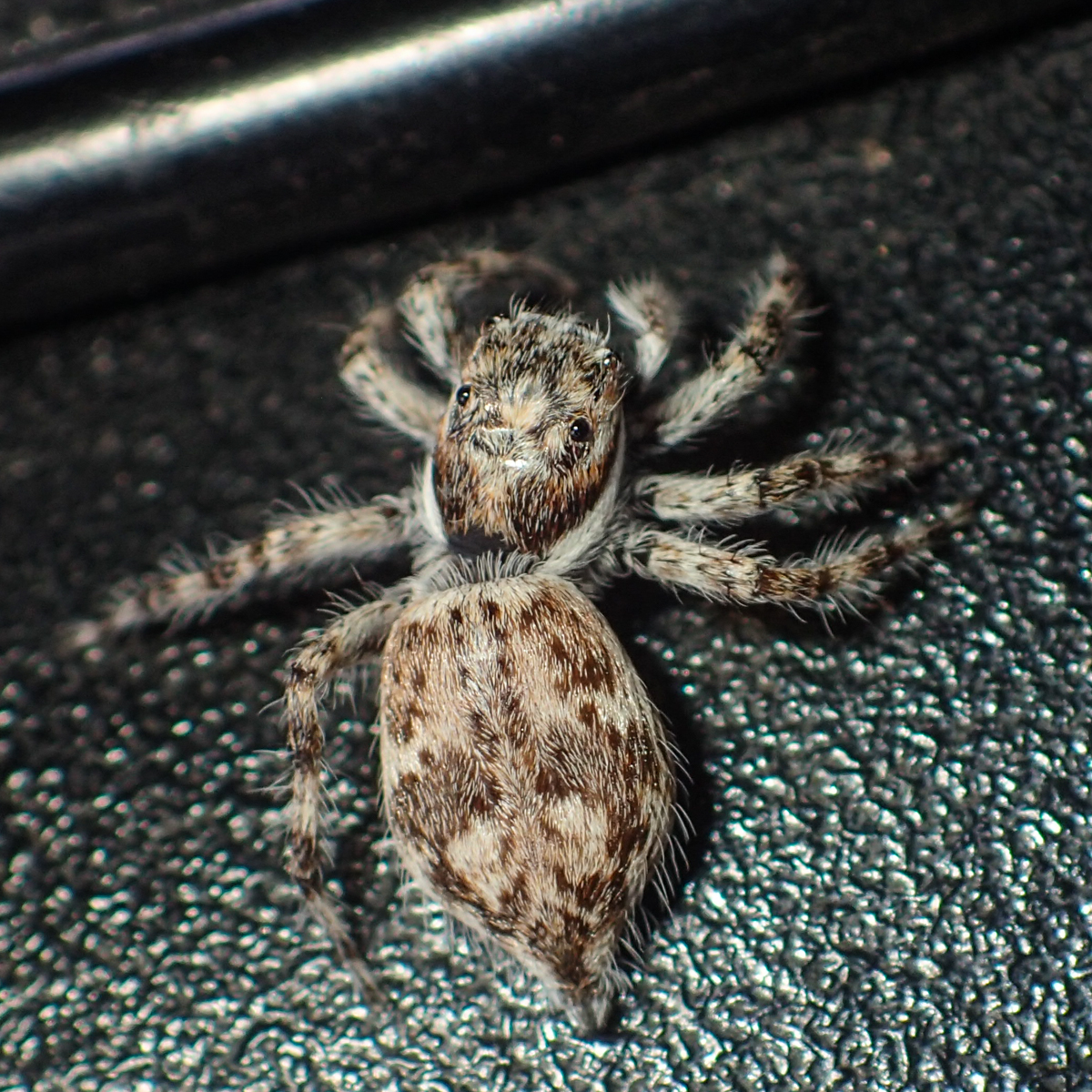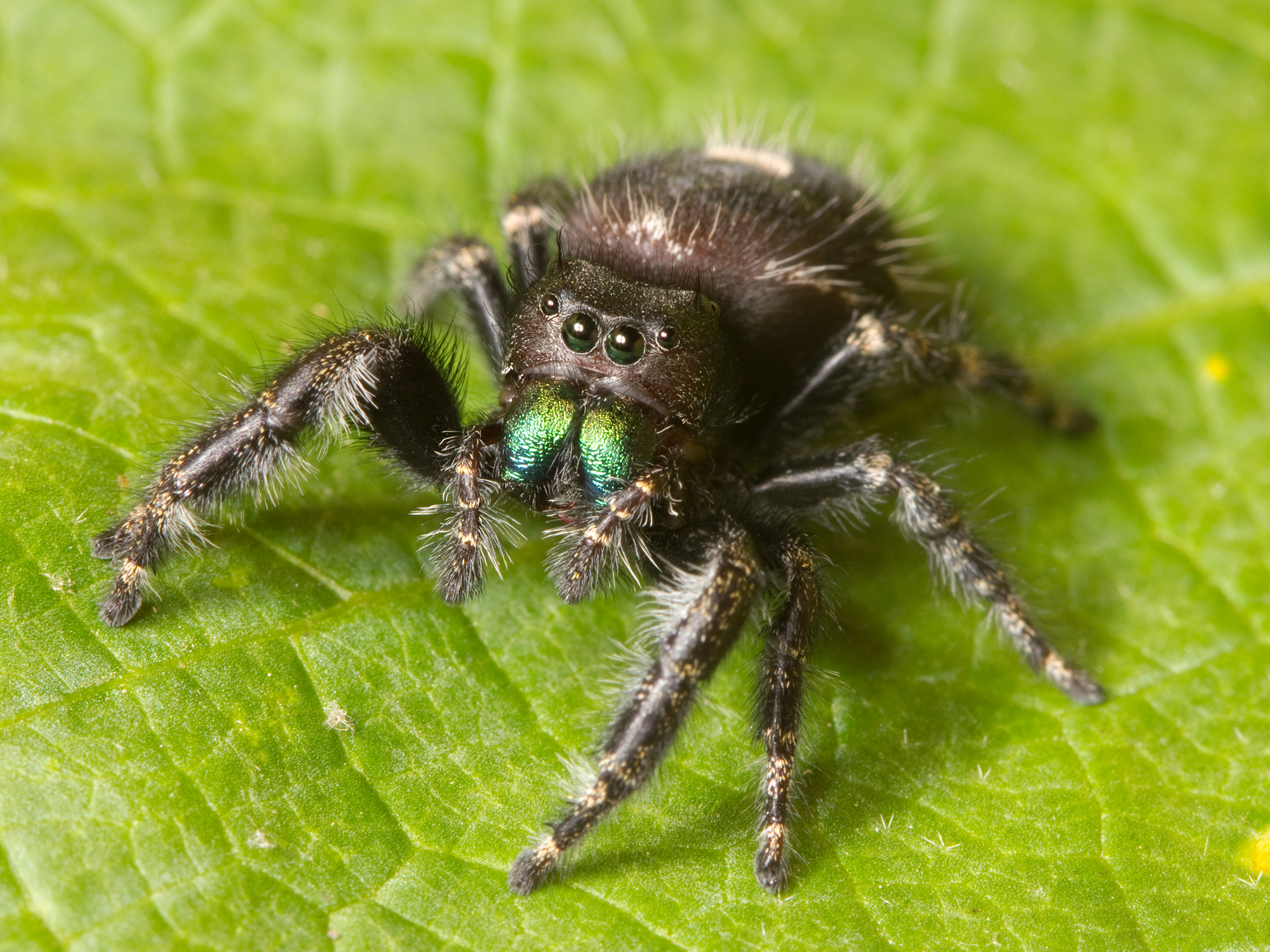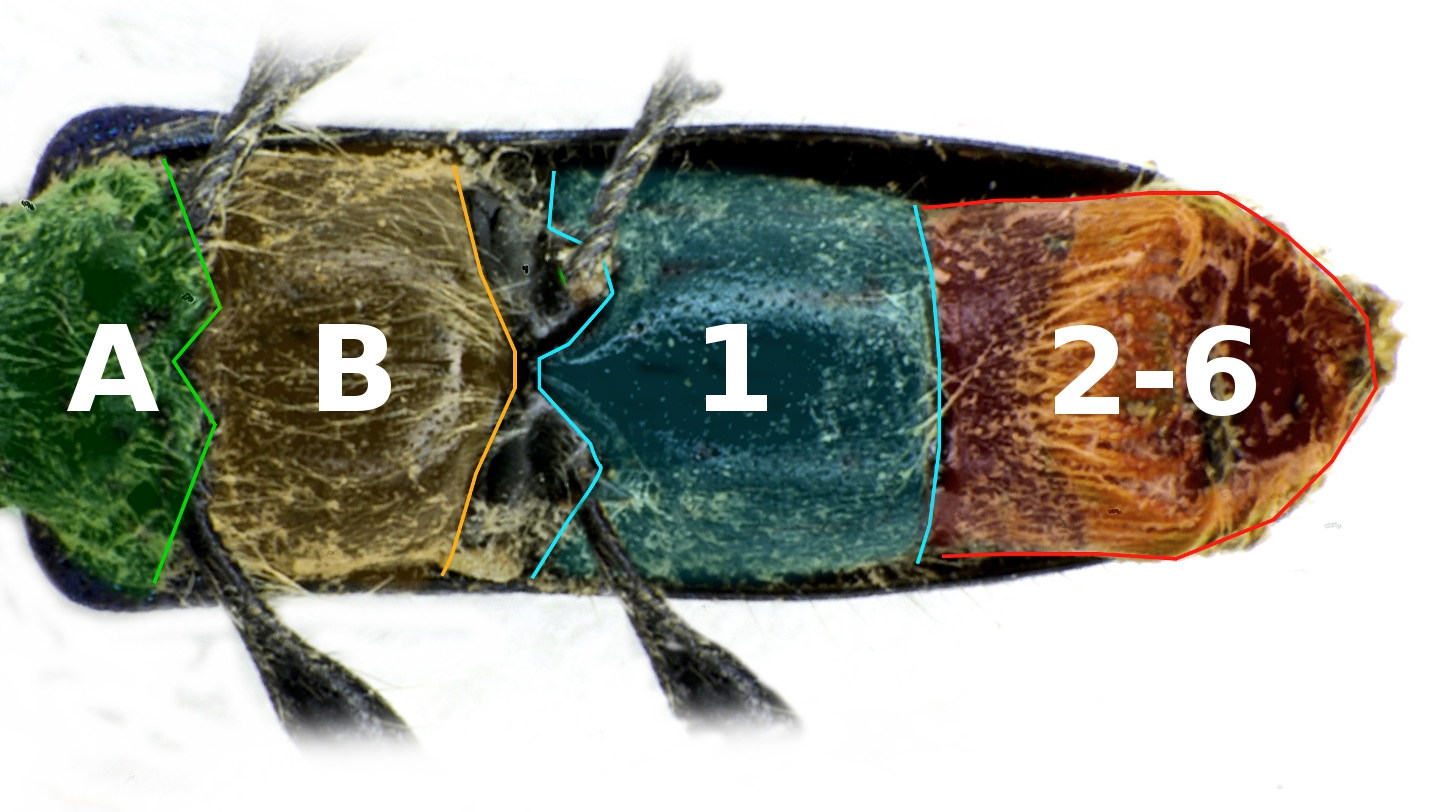|
Stenaelurillus Modestus
''Stenaelurillus modestus'' is a species of jumping spider in the genus '' Stenaelurillus'' that lives in South Africa. The species is a specialist that preys on '' Odontotermes'' termites, although its venom is also effective against other prey. The spider is medium-sized, with a brown cephalothorax between in length and a black abdomen between long. It is generally black or dark brown in colour. The carapace has a border of white hairs and the abdomen is edged with bristles. The male has white patches on its abdomen. The male has darker legs, generally dark brown or black, while the female has brownish-yellow legs. It is distinguished from other members of the genus by the male's elongated palpal bulb and straight embolus, and the horseshoe-shaped depression in the female's epigyne. It was first described in 2014 by Wanda Wesołowska. Taxonomy ''Stenaelurillus modestus'' is a species of jumping spider, a member of the family Salticidae, that was first described by the Polis ... [...More Info...] [...Related Items...] OR: [Wikipedia] [Google] [Baidu] |
Wanda Wesołowska
Wanda Wesołowska (born 11 August 1950) is a Polish zoologist known for her work with jumping spiders. She has described more species of jumping spider than any contemporary writer, and is second only to Eugène Simon in the history of arachnology. Originally a student of ornithology, she developed an interest in jumping spiders while still a student at the Siedlce University of Natural Sciences and Humanities in the 1970s. Wesołowska published her first work in 1981, which included the description of nine new species of spiders, the first in what would be a prolific career. She moved to the University of Wrocław to continue her studies, and completed her doctoral thesis that described 44 new species of the genus ''Heliophanus''. She joined the faculty of the University of Wrocław in 1985, received a habilitation in 2000, and remained a Academic tenure, tenured professor at the university until her retirement in 2020. Her research has focused on the description, taxonomy and ... [...More Info...] [...Related Items...] OR: [Wikipedia] [Google] [Baidu] |
Eugène Simon
Eugène Louis Simon (; 30 April 1848 – 17 November 1924) was a French naturalist who worked particularly on insects and spiders, but also on birds and plants. He is by far the most prolific spider Taxonomy (biology), taxonomist in history, describing over 4,000 species. Work on spiders His most significant work was ''Histoire Naturelle des Araignées'' (1892–1903), an encyclopedic treatment of the spider genera of the world. It was published in two volumes of more than 1000 pages each, and the same number of drawings by Simon. Working at the National Museum of Natural History (France), Muséum National d'Histoire Naturelle in Paris, it took Simon 11 years to complete, while working at the same time on devising a taxonomic scheme that embraced the known taxa. Simon described a total of 4,650 species, and as of 2013 about 3,790 species are still considered valid. The International Society of Arachnology offers a Simon Award recognising lifetime achievement. The Eocene fos ... [...More Info...] [...Related Items...] OR: [Wikipedia] [Google] [Baidu] |
Spinnerets
A spinneret is a silk-spinning organ of a spider or the larva of an insect. Some adult insects also have spinnerets, such as those borne on the forelegs of Embioptera. Spinnerets are usually on the underside of a spider's opisthosoma, and are typically segmented. While most spiders have six spinnerets, some have two, four, or eight. They can move both independently and in concert. Most spinnerets are not simple structures with a single orifice producing a single thread, but complex structures of many microscopic spigots, each producing one filament. This produces the necessary orientation of the protein molecules, without which the silk would be weak and useless. Spigots can be singular or found in groups, which also permits spiders to combine multiple filaments in different ways to produce many kinds of silk for various purposes. Spinneret morphology can help arachnologists identify the taxon of a specimen and the specific morphology of a spigot can determine its use as wel ... [...More Info...] [...Related Items...] OR: [Wikipedia] [Google] [Baidu] |
Maxilla (arthropod Mouthpart)
In arthropods, the maxillae (singular maxilla) are paired structures present on the head as mouthparts in members of the clade Mandibulata, used for tasting and manipulating food. Embryologically, the maxillae are derived from the 4th and 5th segment of the head and the maxillary palps; segmented appendages extending from the base of the maxilla represent the former leg of those respective segments. In most cases, two pairs of maxillae are present and in different arthropod groups the two pairs of maxillae have been variously modified. In crustaceans, the first pair are called maxillulae (singular maxillula). Modified coxae at the base of the pedipalps in spiders are also called "maxillae", although they are not homologous with mandibulate maxillae. Myriapoda Millipedes In millipedes, the second maxillae have been lost, reducing the mouthparts to only the first maxillae which have fused together to form a gnathochilarium, acting as a lower lip to the buccal cavity and the ... [...More Info...] [...Related Items...] OR: [Wikipedia] [Google] [Baidu] |
Labium (arthropod Mouthpart)
The mouthparts of arthropods have evolution, evolved into a number of forms, each adaptation, adapted to a different style or mode of feeding. Most mouthparts represent modified, paired appendages, which in ancestral forms would have appeared more like legs than mouthparts. In general, arthropods have mouthparts for cutting, chewing, piercing, sucking, shredding, siphoning, and filtering. This article outlines the basic elements of four arthropod groups: insects, myriapods, crustaceans and chelicerates. Insects are used as the model, with the novel mouthparts of the other groups introduced in turn. Insects are not, however, the Arthropod#Classification of arthropods, ancestral form of the other arthropods discussed here. Insects Insect mouthparts exhibit a range of forms. The earliest insects had chewing mouthparts. Specialisation includes mouthparts modified for siphoning, piercing, sucking and sponging. These modifications have evolved a number of times. For example, m ... [...More Info...] [...Related Items...] OR: [Wikipedia] [Google] [Baidu] |
Chelicerae
The chelicerae () are the arthropod mouthparts, mouthparts of the subphylum Chelicerata, an arthropod group that includes arachnids, horseshoe crabs, and sea spiders. Commonly referred to as "jaws", chelicerae may be shaped as either articulated fangs, or as a type of pincer_(biology), pincers. Some chelicerae, such as those found on nearly all spiders, are hollow and contain (or are connected to) venom glands, used to inject venom into prey or a perceived threat. Both pseudoscorpions and Opiliones , harvestmen have additional structures on their chelicerae that are used for grooming (papillae in pseudoscorpions, cheliceral teeth in Opiliones). In ''Paratrechalea'', males and females have shown to have a chelicerae dimorphism, because the chelicerae is used as a mating signal for females. Types Chelicerae can be divided into three kinds: jackknife chelicerae, scissor chelicerae, and three-segmented wikt:chelate, chelate chelicerae. Jackknife chelicerae The jackknife chelicer ... [...More Info...] [...Related Items...] OR: [Wikipedia] [Google] [Baidu] |
Clypeus (arthropod Anatomy)
The clypeus is one of the sclerites that make up the face of an arthropod. In insects, the clypeus delimits the lower margin of the face, with the labrum articulated along the ventral margin of the clypeus. The mandibles bracket the labrum, but do not touch the clypeus. The dorsal margin of the clypeus is below the antennal sockets. The clypeus is often well-defined by sulci ("grooves") along its lateral and dorsal margins, and is most commonly rectangular or trapezoidal in overall shape. The post-clypeus is a large nose-like structure that lies between the eyes and makes up much of the front of the head in cicadas. In spider Spiders (order (biology), order Araneae) are air-breathing arthropods that have eight limbs, chelicerae with fangs generally able to inject venom, and spinnerets that extrude spider silk, silk. They are the largest order of arachnids and ran ...s, the clypeus is generally the area between the anterior edge of the carapace and the anterior eyes ... [...More Info...] [...Related Items...] OR: [Wikipedia] [Google] [Baidu] |
Sternum (arthropod Anatomy)
The sternum (: sterna) is the ventral portion of a segment of an arthropod thorax or abdomen. In insects, the sterna are usually single, large sclerites, and external. However, they can sometimes be divided in two or more, in which case the subunits are called sternites, and may also be modified on the terminal abdominal segments so as to form part of the functional genitalia, in which case they are frequently reduced in size and development, and may become internalized and/or membranous. For a detailed explanation of the terminology, see Kinorhynchs have tergal and sternal plates too, though seemingly not homologous with those of arthropods.Sørensen, M. V. et al. Phylogeny of Kinorhyncha based on morphology and two molecular loci. PLoS One 10, 1–33 (2015). Ventrites are externally visible sternites. Usually the first sternite is covered up, so that ventrite numbers do not correspond to sternite numbers. The term is also used in other arthropod groups such as crustaceans, ... [...More Info...] [...Related Items...] OR: [Wikipedia] [Google] [Baidu] |
Spider Vision
The eyes of spiders vary significantly in their structure, arrangement, and function. They usually have eight, each being a simple eye with a single lens (optics), lens rather than multiple units as in the compound eyes of insects. The specific arrangement and structure of the eyes is one of the features used in the identification and classification of different species, genera, and families. Most Haplogynae, haplogynes have six eyes, although some have eight (Plectreuridae), four (e.g., ''Tetrablemma'') or even two (most Caponiidae). In some cave species, there are no eyes at all (e.g. ''Stalita taenaria''). Sometimes one pair of eyes is better developed than the rest. Several families of hunting spiders, such as jumping spiders and wolf spiders, have fair to excellent vision. The main pair of eyes in jumping spiders even sees in colour. Structure and anatomy Spiders' eyes are Simple eye in invertebrates, simple eyes, or ''ocelli'' (singular ''ocellus''), meaning their eyes have ... [...More Info...] [...Related Items...] OR: [Wikipedia] [Google] [Baidu] |
Jerzy Prószyński
Jerzy Prószyński (born 1935 in Warsaw) is a Polish arachnologist specializing in systematics of jumping spiders (family Salticidae). He is a graduate of the University of Warsaw, a long-term employee of the Siedlce University of Natural Sciences and Humanities and the Institute of Zoology of the Polish Academy of Sciences in Warsaw. Biography In 1957 he completed his biological studies at the University of Warsaw. During his studies he was employed at the Institute of Zoology of the Polish Academy of Sciences in Warsaw, where he conducted research on spiders in the Kampinos Forest. Between 1963 and 1967 he lectured on zoology at the University of Ghana. In 1966 he obtained his Ph.D. at the Adam Mickiewicz University in Poznań. A year later he was given the opportunity to pursue a postdoctoral fellowship at Harvard University Harvard University is a Private university, private Ivy League research university in Cambridge, Massachusetts, United States. Founded ... [...More Info...] [...Related Items...] OR: [Wikipedia] [Google] [Baidu] |
Clade (biology)
In biology, a clade (), also known as a monophyletic group or natural group, is a group of organisms that is composed of a common ancestor and all of its descendants. Clades are the fundamental unit of cladistics, a modern approach to taxonomy adopted by most biological fields. The common ancestor may be an individual, a population, or a species (extinct or extant). Clades are nested, one in another, as each branch in turn splits into smaller branches. These splits reflect evolutionary history as populations diverged and evolved independently. Clades are termed ''monophyletic'' (Greek: "one clan") groups. Over the last few decades, the cladistic approach has revolutionized biological classification and revealed surprising evolutionary relationships among organisms. Increasingly, taxonomists try to avoid naming taxa that are not clades; that is, taxa that are not monophyletic. Some of the relationships between organisms that the molecular biology arm of cladistics has revealed i ... [...More Info...] [...Related Items...] OR: [Wikipedia] [Google] [Baidu] |
Tribe (biology)
In biology, a tribe is a taxonomic rank above genus, but below family and subfamily. It is sometimes subdivided into subtribes. By convention, all taxa ranked above species are capitalized, including both tribe and subtribe. In zoology, the standard ending for the name of a zoological tribe is "-ini". Examples include the tribes Caprini (goat-antelopes), Hominini (hominins), Bombini (bumblebees), and Thunnini (tunas). The tribe Hominini is divided into subtribes by some scientists; subtribe Hominina then comprises "humans". The standard ending for the name of a zoological subtribe is "-ina". In botany, the standard ending for the name of a botanical tribe is "-eae". Examples include the tribes Acalypheae and Hyacintheae. The tribe Hyacintheae is divided into subtribes, including the subtribe Massoniinae. The standard ending for the name of a botanical subtribe is "-inae". In bacteriology, the form of tribe names is as in botany, e.g., Pseudomonadeae, based on the ge ... [...More Info...] [...Related Items...] OR: [Wikipedia] [Google] [Baidu] |





